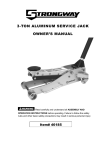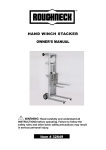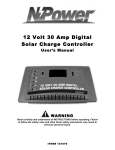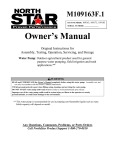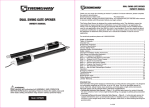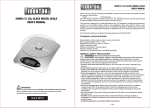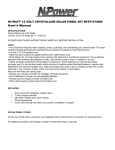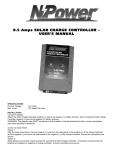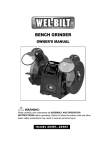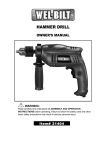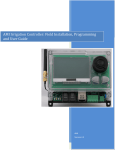Download 23795 Manual - Northern Tool + Equipment
Transcript
2.5-GALLON AIR COMPRESSOR USER’S MANUAL WARNING: Read carefully and understand all ASSEMBLY AND OPERATION INSTRUCTIONS before operating. Failure to follow the safety rules and other basic safety precautions may result in serious personal injury. Item# 23795 Thank you very much for choosing a Wel-Bilt™ product. For future reference, please complete the owner’s record below: Model: _______________ Purchase Date: _______________ Save the receipt, warranty and these instructions. It is important that you read the entire manual to become familiar with this product before you begin using it. This air compressor is designed for certain applications only. The distributor cannot be responsible for issues arising from modification. We strongly recommend this item not be modified and/or used for any application other than that for which it was designed. If you have any questions relative to a particular application, DO NOT use this product until you have first contacted the distributor to determine if it can or should be performed on the product. For technical questions please call 1-800-222-5381. TECHNICAL SPECIFICATIONS 0.27 peak HP direct drive, PUMP oil-less PEAK HORSEPOWER 0.27 HP MOTOR 3900 RPM POWER 120 V, 60 Hz, 2 A, Single AIR TANK CAPACITY 2.5 Gallons CUT-IN PRESSURE 70 PSI CUT-OUT PRESSURE 100 PSI Air delivery (SCFM) @ 40 PSI 1 Air delivery (SCFM) @ 90 PSI 0.7 POWER CORD SJT 18 AWG / 80” (2.04 m) SAFETY GUIDELINES This manual contains information that relates to PROTECTING PERSONAL SAFETY and PREVENTING EQUIPMENT PROBLEMS. It is very important to read this manual carefully and understand it thoroughly before using the air compressor. The symbols listed below are used to indicate this information. POTENTIAL HAZARD THAT WILL RESULT IN SERIOUS INJURY OR LOSS OF LIFE POTENTIAL HAZARD THAT COULD RESULT IN SERIOUS INJURY OR LOSS OF LIFE POTENTIAL HAZARD THAT MAY RESULT IN MODERATE INJURY OR DAMAGE TO EQUIPMENT 1. RISK OF EXPLOSION OR FIRE. Do not spray flammable liquids in a confined area. It is normal for the motor and pressure switch to produce sparks while operating. If sparks come into contact with vapors from gasoline or other solvents, they may ignite and cause a fire or an explosion. Do not smoke while spraying. Do not spray where sparks or flames are present. Keep the air compressor as far away from the spraying area as possible. Always operate the air compressor in a well-ventilated area. 2. RISK OF ELECTRIC SHOCK. All wiring must be installed by a licensed electrician, in accordance with all local and national codes. In order to avoid electric shock, do not use an electric air compressor outdoors when it is raining or on a wet surface. 3. RISK OF BURSTING. Rust can weaken the tank. Drain the condensed water from the tank after each use in order to reduce rusting. Welding or making modifications to the air tank can severely diminish the strength of the tank, and could cause an extremely hazardous condition. Do not weld, drill, or modify the air tank. If a leak is detected in the tank, replace the tank immediately. 4. RISK OF INJURY. Be sure to shut off the air compressor and unplug it from the outlet when task is complete. Bleed all pressure from the system before servicing the air compressor or when it is not in use. Do not use the air compressor with the shrouds removed. Contact with moving parts could cause serious injury. 5. RISK OF BURSTING. Check the maximum pressure rating in the manual or the serial number label. The compressor outlet pressure must be regulated so that it does not exceed the maximum pressure rating. Relieve all pressure in your hose before removing or attaching accessories. 6. RISK OF BURSTING. Do not adjust the pressure switch or relief valve for any reason. They have been preset at the factory for this air compressor’s maximum pressure. Tampering with the pressure switch or the relief valve may cause personal injury or property damage. 7. RISK OF BURNS. The pump and the manifold generate high temperatures. In order to avoid burns or other injuries, do not touch the pump, the manifold, or the transfer tube while the air compressor is running. Allow the parts to cool down before handling or servicing. Keep children away from the air compressor at all times. 8. RISK TO BREATHING. Carefully read all labels when you are spraying paints or toxic materials, and follow the safety instructions. Use a respirator mask if there is a chance of inhaling anything that is being sprayed. Do not directly inhale the compressed air produced by an air compressor. 9. RISK OF EYE INJURY. Wear ANSI Z87.1 approved safety goggles when using an air compressor. Do not point any nozzle or sprayer toward a person or any part of the body. Serious injury may occur if the spray penetrates the skin. 1. Pull the pressure relief valve ring every day in order to ensure that the valve is functioning properly. 2. The air compressor must be located in a well-ventilated area for cooling, and must be a minimum of 12in. (31cm) away from the nearest wall. 3. Protect your air hose and the power cord from damage and puncture. Inspect them for weak or worn spots every week, and replace them if necessary. 4. Always wear hearing protection when using an air compressor. Failure to do so may result in hearing loss. 5. Do not operate the air compressor if it is not in a stable position. Do not operate the air compressor on a rooftop or an elevated position that could allow the unit to fall or be tipped over. KNOW YOUR AIR COMPRESSOR BASIC COMPRESSOR FEATURES D E A G B F H J C I A--------ELECTRIC MOTOR & AIR COMPRESSOR PUMP B--------ON/OFF SWITCH C--------AIR LINE OULET D--------REGULATED PRESSURE GAUGE E--------TANK PRESSURE GAUGE F--------AIR PRESSURE REGULATOR G--------PRESSURE RELIEF VALVE H-------- AIR TANK I----------AIR TANK DRAIN VALVE J----------- POWER CORD KNOW YOUR AIR COMPRESSOR A. ELECTRIC MOTOR: The motor is used to power the pump. It is equipped with a thermal overload protector and an automatic reset. If the motor overheats for any reason, the thermal overload protector will shut it down in order to prevent the motor from being damaged. The motor will automatically restart when it has cooled completely. AIR COMPRESSOR PUMP: The pump compresses the air and discharges it into the tank via the piston that moves up and down in the cylinder B. (ON/OFF) (PRESSURE SWITCH): This switch turns the air compressor on and off. It is operated manually, and when it is in the ON position, it allows the motor to start if the pressure in the air tank is below the factory set ‘cut-in’ pressure, and allows the motor to stop if the pressure in the air tank reaches the factory set ‘cut-out’ pressure. Be sure to set this switch to the OFF position when the air compressor is not being used and before unplugging the air compressor. C. AIR LINE OUTLET: The outlet is connected to the 1/4in. (6.4mm) NPT air hose. D. REGULATED PRESSURE GAUGE: Display the current line pressure. It is regulated by the regulator knobs. E. TANK PRESSURE GAUGE: Indicates tank pressure in PSI. F. AIR PRESSURE REGULATOR: A control that adjusts the line pressure to the proper amount needed to operate spray guns and air tools. Do not exceed the tool’s maximum working pressure. G. PRESSURE RELIEF VALVE: This valve is used to prevent system failure by draining pressure from the system when it reaches a preset level if the pressure switch has not shut down the motor. It will pop open automatically, or it can be activated manually by pulling the ring on the valve. H. AIR TANK: The tank is where the compressed air is stored. I. AIR TANK DRAIN VALVE: The drain valve is used to remove moisture from the air tank after the compressor is shut off. Do not attempt to open the drain valve when there is more than 10 PSI of air pressure in the tank. J. POWER CORD: This air compressor should be used on a nominal 115V grounded circuit. Use a power cord that is equipped with a grounding plug. Verify that the air compressor is plugged into an outlet that has the same configuration as the plug (see Figure 1). Do not use an adaptor with this air compressor. BEFORE YOU START General Usage Description This Air Compressor is ideal for a number of light-duty applications such as inflation and cleaning. The small 2.5-gallon tank is lightweight for easy portability. It features an oil-less pump for low maintenance. Compatible Compressor & Air Tool - Guidelines for Proper Usage & Operation Always ensure the use of appropriately matched air tools with your Air Compressor. Be sure that the air compressor being used can supply the appropriate volume, pressure and delivery rate of air to the tool(s) without running continuously. Using tools or combinations of tools that together or separately require more than the air compressor can deliver will void the compressor guarantee/warranty. EXTENSION CORDS: Avoid the use of extension cords whenever possible. If an extension cord must be used, it must have a minimum wire size of 12 AWG, and must be no longer than 50 feet (15m). Use only a 3-wire extension cord that has a 3-pronged grounding plug, and plug it into a 3-holed outlet that is suitable for the compressor’s plug. Whenever possible, utilize a longer air hose instead of an extension cord. Grounded outlet Plug 个gg 120 V/2 A Grounding Pin Figure 1 If the compressor is used outdoor, use only extension cords that are intended for outdoors only. Before You Start – Air System: 1. A filter-regulator-lubricator is recommended and should be located as close to the air-powered tool as possible. (see Fig.4) 2. If a filter-regulator-lubricator is not installed, place 2-6 drops of compressor oil into the NPT inlet plug of your air-powered tools before each use. 3. If installed, keep air filter clean. A dirty filter will reduce the air pressure to the tool causing a reduction in power, efficiency and performance in general. 4. For better performance, install a quick connector in your tool and quick coupler on your hose. 5. Be sure all connections in air supply system are sealed to prevent air loss. OPERATION Daily Start-Up 1. Close the tank drain valve (see D). Turn in the clockwise direction. 2. Plug in the power cord. High temperatures are generated by the electric motor and the pump. To prevent burns or other injuries, DO NOT touch the air compressor while it is running. Allow it to cool before handing or servicing. Keep children away from the air compressor at all times 3. Turn the ON/OFF switch to the ON position (see C) When adjusting from a higher to a lower pressure, turn the knob counter-clockwise past the desired setting; then, turn clockwise to reach the desired pressure. Do not exceed operating pressure of the tool or accessory being used. 4. If a pressure regulator is present on your air compressor, adjust it to the working pressure of the tool. SHUTDOWN 1. Turn the ON/OFF switch to the OFF position. 2. Unplug the power cord. 3. Reduce pressure in the tank through the outlet hose. 4. You can also pull the relief valve ring (see E) and keep it open to relieve pressure in the tank. Escaping air and moisture can propel debris that may cause eye injury. Wear safety goggles when opening drain valve. 5. Tip the air compressor so the tank drain valve is at the bottom of the tank. Then open the tank drain valve (see B) to allow moisture to drain from the tank. E MAINTENANCE To avoid personal injury, always shut off and unplug the unit and relieve all air pressure from the system before performing any service on the air compressor. Regular maintenance will ensure trouble-free operation. The items listed in the chart should be inspected on a regular basis. DESCRIPTION/REASON SERVICE INTERVAL Drain the tank. Through normal operation of your air compressor, condensation water will accumulate in the tank. To prevent corrosion of the tank from the inside, condensation must be drained at the end of every workday. Be sure to wear protective goggles. Relieve the air pressure in the system and open the drain valve on the bottom of the tank to drain. In cold conditions, it is especially important to drain the tank after each use to reduce the chance of problems resulting from the freezing of condensation water. Daily Check the relief valve. Pull/activate the relief valve daily to ensure that it is operating properly and to clear the valve of any possible obstructions. Daily Test for leakage. Check that all connections are tight. Small leaks in any of the tank, hoses, connections or transfer tubes will substantially reduce the air compressor and tool performance. Spray a small amount of soapy water around the area of suspected leaks with a spray bottle. If bubbles appear, repair, replace or re-seal the faulty component. Do not over tighten any connections. Monthly Storage. Before storing the unit for a long period, use an air blow gun to clean all dust and debris from the air compressor. Disconnect and coil the power cord up. Drain all moisture from the tank. Pull the pressure relief valve to release all pressure from the tank. Cover the entire unit to protect it from moisture and dust. As needed ITEM TROUBLESHOOTING If any of the following symptoms appears while operating the tool, stop using the tool immediately, or serious personal injury could result. Only authorized service centre should perform repairs on this tool. Disconnect the electrical plug and disconnect any tools from air supply before attempting any adjustment. NOTE: Troubleshooting problems may have similar causes and solutions. PROBLEM Compressor motor will not run or start. POSSIBLE CAUSE Power cord is not plugged in. Pressure Switch is in “OFF” position. SOLUTION Plug cord into grounded outlet. Wrong gauge wire or length of extension cord. Check specifications for proper gauge wire and cord length. Motor thermal overload switch is tripped Turn air compressor off, wait until motor is cool, then check motor circuit breaker. -Replace fuse or reset circuit breaker. -Check for proper fuse amperage. -Check for low voltage conditions. -Disconnect any other electrical appliances from circuit or operate air compressor on a dedicated circuit. Motor will start automatically when tank pressure drops below cut-in pressure of pressure tank. Remove and clean or replace. Contact authorized service center. Fuse blown or circuit breaker is tripped. Air tank pressure exceeds preset pressure switch limit. Check valve is stuck open. Electrical connections are loose. Possible defective motor, capacitor or check valve. Low Voltage. Motor hums but cannot run, or runs slowly. Fuses blow/circuit breaker trips repeatedly. Unit is plugged into an extension cord. Turn switch to “ON” or “AUTO” position. Contact authorized service center. Check power source (outlet or generator) with volt meter. Remove extension cord. Tip: It is better to use a longer hose instead of an extension cord. Shorted, or open motor winding. Contact authorized service center. replacement may be required. Check valve is defective. Contact authorized service center. Parts may require replacement. Check for proper fuse or breaker, use time-delay fuse of the proper size. Disconnect other electrical appliances from circuit or operate air compressor on its own branch circuit. Disconnect any other electrical appliances from circuit or operate compressor on its own dedicated circuit. Remove extension cord. Tip: It is better to use a longer hose instead of an extension cord. Incorrectly sized fuse or circuit – circuit overloaded. Circuit is overloaded. Unit is plugged into an extension cord. Motor Check valve is defective. PROBLEM Motor runs continuously when in the Auto mode. SOLUTION Pressure switch does not shut off motor when air compressor reaches cut-out pressure and safety relief valve activates. Air compressor is not large enough. Move the pressure switch to the OFF position. If the motor does not shut off, unplug the air compressor. Contact authorized service center. Lack of proper ventilation/room temperature too high. Unit is plugged into an extension cord. Dirt-covered cooling surfaces. Regulator does not regulate pressure. Low pressure or not enough air. Excessive moisture in discharge air. Parts POSSIBLE CAUSE Low voltage. Thermal overload protector cuts out repeatedly. Contact authorized service center. may require replacement. Check air requirement of accessory used. If it is higher than SCFM and pressure supplied by compressor, a larger compressor is needed. Most accessories are rated at 25% of actual SCFM while running continuously. Check power source (outlet or generator) with volt meter. Relocate air compressor to an area with cool, dry and well-circulated air. Remove extension cord. Tip: It is better to use a longer hose instead of an extension cord. Allow air compressor to cool-down, then Clean all cooling surfaces of pump and motor thoroughly. Dirty or damaged regulator internal parts. Replace regulator. Contact authorized service center. Fittings leak. Check fittings with soapy water. Tighten or reseal leaking fittings. But do not over tighten. Tank drain valve is open. Close drain valve. Restricted air intake. Clean or replace air filter element. Prolonged excessive use of air. Decrease amount of air used. Hole in air hose. Check and replace if necessary. Tank leaks. Replace unit immediately. DO NOT attempt to repair. Valve leaks. Check and replace worn parts. Excessive water in air tank. Drain Tank. High humidity. Move air compressor an area of lower humidity or install an in-line air filter. PARTS DRAWING PARTS LIST Part no. Description Qty Part no. Description Qty 1 Rubber foot 3 12 On/off switch 1 2 Drain valve 1 13 Brass nipple 2 3 Tank 1 14 Nut 2 4 Regulator 1 15 Aluminum pipe 1 5 Relief valve 1 16 Fan 1 6 Pressure gauge 2 17 Rubber pillow 1 7 Pump assembly 1 18 Pressure switch 1 8 Power cord 1 19 Fuse 1 9 Screw 8 20 circuit board 1 10 Housing 1 21 Rubber pad 2 11 Handle 1 For replacement parts and technical questions, please call 1-800-222-5381. WARRANTY 1-year limited warranty Distributed by: Northern Tool + Equipment Co., Inc. Burnsville, Minnesota 55306-6936 NorthernTool.com Made in China

















